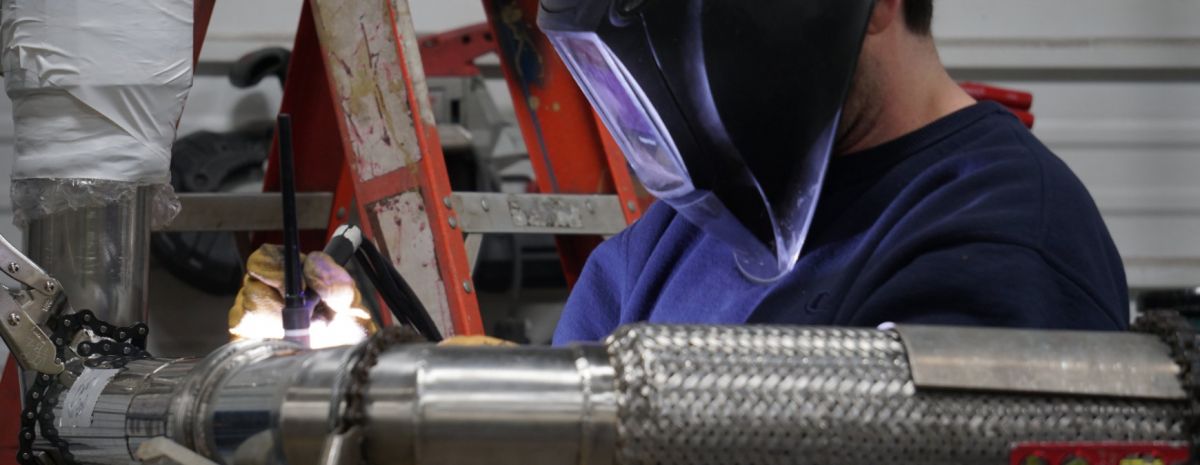TWS is a Great Training Option for Everyone
Learn more about how we can prepare you to advance your career.
Once you’ve completed your welding program, where could your newly learned skills take you in the job market?
Though it’s pretty easy to imagine working in a metal shop, there could be a whole wide world of welding possibilities ahead of you, from fusing the metal joints for race cars and fine electronics to helping to construct massive ships and towering skyscrapers.1
However, specific types of welding processes may be used in each field. Knowing what kind of welding is used in the industry you want to enter can help you prepare for interviews with employers in that field.2,3
Here’s a quick breakdown of industries by welding process to help you with your transition from trade school to career.
Have You Considered a Career in the Skilled Trades?
Fill out the form to recieve a no obligation info packet.
Where to Take Your Welding Skills in the Job Market

There are several different types of welding used across the job market.2 If you find that a certain industry appeals to you, you might want to focus on sharpening the welding skills needed for positions in that field.3
It’s not uncommon for employers to interview job applicants about their welding training and knowledge about the processes needed for the position. Many employers also test welders on required welding processes.3
Let’s take a look at four common types of welding and the industries in which they’re typically used.
1. MIG Welding and FCAW
Gas metal arc (MIG) welding and flux-cored arc welding (FCAW) are used in many industries for a range of applications:2
- Heavy automotive repair
- Equipment and facility maintenance and repair
- Home and hobby
- Farming and ranching
- Manufacturing
- Pipe fabrication
- Railroad equipment2
Because the weld is partially created from the consumable wire electrode distributed to the weld pool via a welding gun, MIG welding can be an excellent choice for welding dissimilar metals together.4
MIG welding can be popular in the manufacturing industry due to its cost-effective operating expense. The welding process is usually faster, and MIG welding parts are often cheaper.5
2. SMAW Welding
Shielded metal arc welding, also called SMAW or stick welding, is another popular option that can work well for a host of industries:2
- Farm and ranch equipment manufacturing
- Building construction
- Pipeline construction
- Storage vessel construction
- Power plant construction
- Chemical plant and refinery construction2
Stick welding can have some advantages:
- Simple equipment and setup
- Easily portable equipment
- Works well outdoors
- Can be used on a wide range of metals
- Tolerant of rust, dirt, oil and other contaminants6
But the process can also have some disadvantages:
- Requires a higher level of skill
- Can take longer to learn in welding training
- Travel speeds tend to be slower
- Deposition rates can be lower
- Cost of deposited weld metal can be higher6
3. TIG Welding
Welders who develop the coordination needed for two-handed welding processes and enjoy a challenge may like TIG welding. The fine control required with TIG welding makes it possible to create clean, high-quality welds, which are ideal for more intricate work using lightweight metals.7
TIG welding is often used on light-gauge stainless steel and a range of nonferrous metals, such as aluminum, copper and magnesium alloys. The process is popular in several industries, including NASCAR fabrication, which requires up to 950 hours of TIG welding per car.7,8,9
Other industries that use TIG welding include automotive manufacturing and auto body repair, as well as the aerospace and aircraft industry.4
A World of Welding Opportunities
Welding jobs can provide opportunities for advancement and career change across industries, with over half of all U.S. products requiring welding, from ocean-going ships to the smartphone you’ve got in your pocket.1,10, 11
Whether you want to help build skyscrapers or race cars, a career in welding can offer you many options.1
1https://www.bls.gov/ooh/production/welders-cutters-solderers-and-brazers.htm#tab-2
2https://www.millerwelds.com/Training/PresentationsQuizzes/IntroToWelding/Welding11/presentation_html5.html
3https://advanced.edu/4-secrets-to-a-successful-welding-interview/
4https://interestingengineering.com/types-of-welding-their-applications-advantages-and-disadvantages
5https://www.americantorchtip.com/blog/mig-vs-tig
6https://www.thefabricator.com/thefabricator/article/arcwelding/stick-electrode-and-welding-basics
7https://cgindustrialglass.com/industrial/tungsten-inert-gas-tig-welding/
8https://www.millerwelds.com/resources/article-library/tig-it-how-a-tig-welder-works-and-when-to-tig-weld
9https://www.weld-ed.org/NR/rdonlyres/F75C7675-0F14-4492-9969-0F3C63F02AFD/6348/InDemand_Book.pdf
10https://www.earlbeck.com/welding-blog/what-is-the-job-outlook-for-welders
11https://www.bls.gov/OOH/production/welders-cutters-solderers-and-brazers.htm#tab-6






